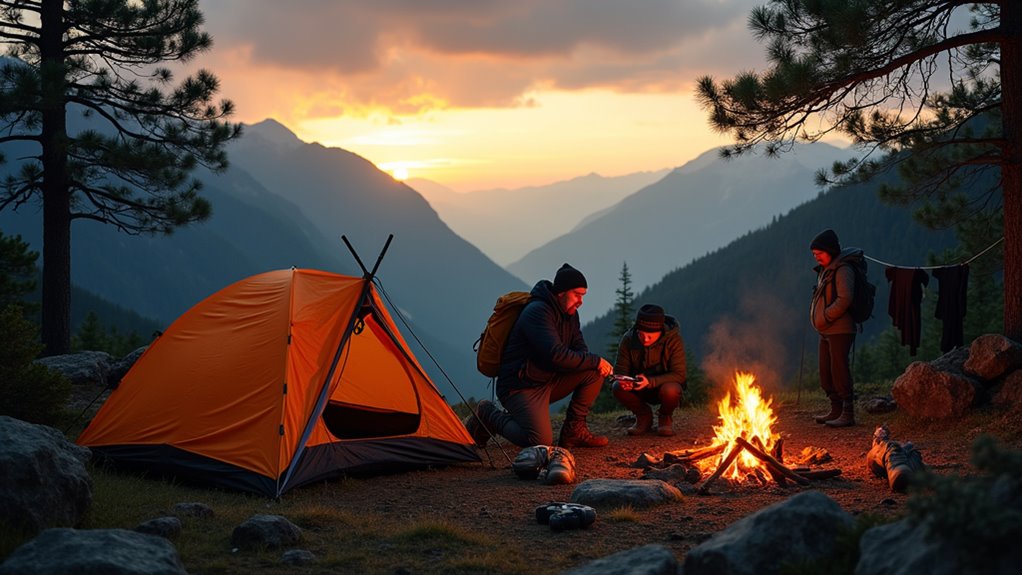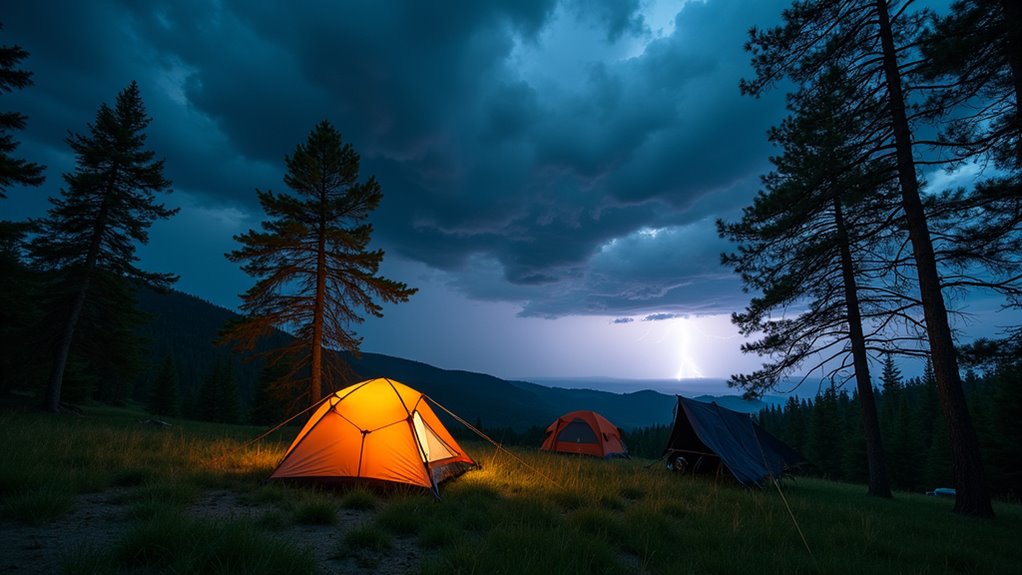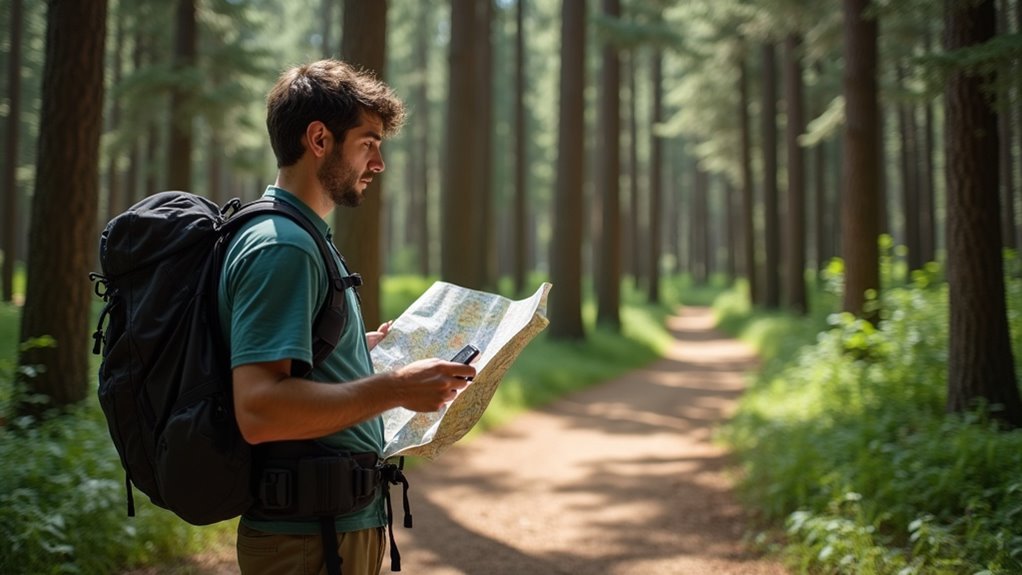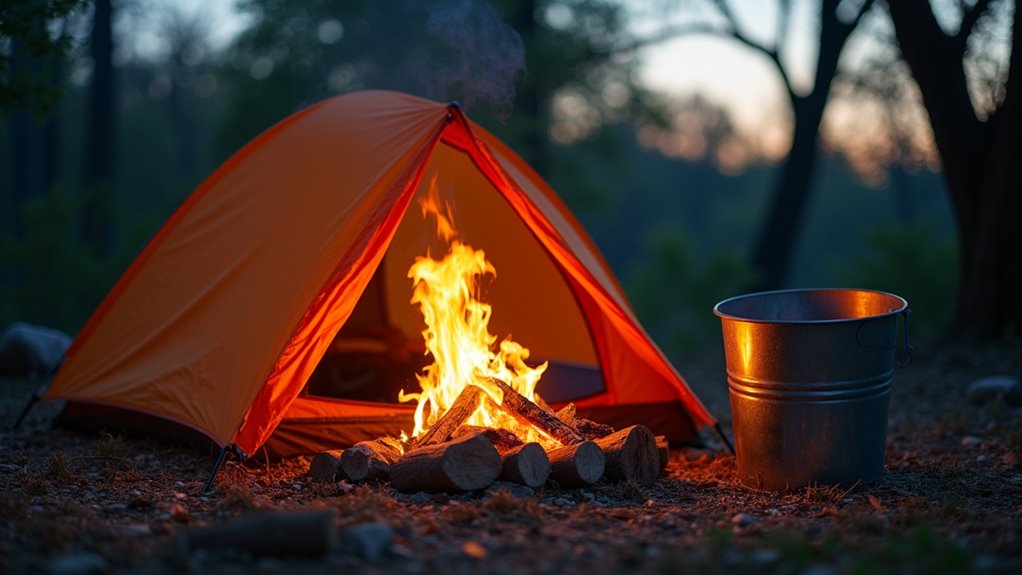Physical Address
304 North Cardinal St.
Dorchester Center, MA 02124
Physical Address
304 North Cardinal St.
Dorchester Center, MA 02124

Face camping's eight hidden dangers that catch even experienced outdoors enthusiasts off-guard, plus the survival tips that could save your trip.
While camping promises peaceful nights under starlit skies, you’re actually stepping into nature’s unpredictable arena where dangers lurk behind every scenic vista. You’ll face sudden storms that can turn your cozy tent into a soggy nightmare, curious wildlife that won’t respect your food boundaries, and equipment failures that’ll leave you stranded. But here’s what most campers don’t realize about these eight common threats—and the simple strategies that separate memorable adventures from potential disasters.

When you’re miles from civilization and dark clouds suddenly roll in, your camping trip can quickly turn from relaxing to dangerous. You’ll need to act fast when weather conditions deteriorate.
First, secure all loose gear immediately. Wind can turn camping chairs and tarps into projectiles. Move everything inside your tent or vehicle. If you don’t have a car nearby, anchor items with rocks or rope.
Don’t let loose camping gear become dangerous projectiles—secure everything inside your tent or anchor with rocks before wind picks up.
Next, reinforce your tent by adding extra stakes and guy-lines. Tighten all connections and lower your tent’s profile if possible. Create drainage channels around your tent to prevent flooding.
Monitor weather conditions using a battery-powered radio or smartphone app. If severe weather’s approaching, consider relocating to your vehicle or a sturdy shelter. Don’t wait until conditions become life-threatening to make this decision.
While a sudden thunderstorm might send you scrambling for shelter, an unexpected bear visit to your campsite presents an entirely different level of danger that requires both prevention and preparation.
You’ll need to store all food, toiletries, and scented items in bear-proof containers or hang them at least twelve feet high and four feet from tree trunks. Never keep food in your tent – bears have incredible noses and can smell food from miles away.
If you encounter wildlife, don’t run or make sudden movements. Back away slowly while making yourself appear larger.
Keep a clean campsite, dispose of waste properly, and consider carrying bear spray in active wildlife areas for added protection.
Just as you might consider whether to rent or buy equipment for your outdoor adventures, weighing the costs and frequency of use should guide your decision on purchasing camping gear versus borrowing or renting items you’ll use infrequently.

Beyond the immediate dangers of wildlife encounters, losing your way in unfamiliar terrain can transform a pleasant camping trip into a genuine survival situation. You’ll face disorientation when trails aren’t marked clearly or when you’ve relied too heavily on smartphone GPS without backup navigation tools.
Prevent navigation failures with these essential strategies:
If you do get lost, stop immediately. Don’t panic or continue wandering aimlessly. Use the STOP method: Sit, Think, Observe, and Plan your next move carefully.
For boat camping adventures, navigation becomes even more critical as you’ll need specialized waterproof gear to protect your maps and electronic devices from moisture while navigating waterways.
Even with careful planning, your essential camping gear will eventually fail you at the worst possible moments. Your tent zipper will jam during a downpour, your camp stove won’t ignite when you’re starving, or your flashlight will die in complete darkness.
Pack backup solutions for critical items. Bring duct tape for quick tent repairs, extra batteries for electronics, and a backup lighter or waterproof matches. Test all gear before leaving home – run your stove, check your tent’s setup, and verify your headlamp’s brightness.
Create a basic repair kit with multi-tool, zip ties, safety pins, and superglue. Learn simple field repairs like patching holes or fixing broken buckles.
Most importantly, don’t rely on single pieces of equipment for essential functions like light, fire, or shelter. If you’re camping with an RV, remember that avoiding common buying mistakes will help ensure your recreational vehicle serves as reliable backup shelter and power source when other gear fails.

Although campfires create the perfect ambiance for storytelling and s’mores, they’re also responsible for thousands of wildfires and camping accidents each year. You’ll need to master proper fire safety techniques to protect yourself, others, and the environment.
Before lighting any fire, check local regulations and fire restrictions. Choose established fire rings whenever possible, and clear a 10-foot radius of flammable materials.
Keep your fire small and manageable—you’re not trying to signal aircraft.
Essential fire safety practices include:
Remember: if it’s too windy to keep embers from flying, don’t light a fire at all. Following these essential camping fire safety tips will help ensure your trip remains both enjoyable and secure.
While you’re managing campfire safety, water safety deserves equal attention since contaminated water can quickly turn your outdoor adventure into a medical emergency. Natural water sources contain bacteria, parasites, and viruses that’ll cause severe illness. Always purify water through boiling, filtration, or purification tablets before drinking.
Dehydration strikes faster outdoors due to increased activity and sun exposure. You’ll need more water than usual – aim for half a gallon daily per person. Watch for early warning signs: headaches, dizziness, dark urine, and fatigue. Don’t wait until you’re thirsty to drink water.
Pack extra water beyond your calculated needs, and know where reliable sources exist along your route. Electrolyte supplements help replace minerals lost through sweating during strenuous activities. Maintaining proper hygiene is equally important, so consider portable camping showers to stay clean when traditional washing facilities aren’t available.

Beyond water safety concerns, remote camping locations present serious challenges when injuries occur since you’re hours away from professional medical help. You’ll need to be your own first responder until rescue arrives or you can reach civilization.
Essential preparation makes the difference between manageable situations and life-threatening emergencies:
Always inform someone about your exact location and expected return time. Consider camping closer to trailheads when traveling solo or with inexperienced companions. Selecting the right camping location from the start can significantly reduce your exposure to unnecessary risks and ensure you’re positioned for easier evacuation if emergencies arise.
When temperatures drop unexpectedly or you’re caught unprepared for cold conditions, hypothermia becomes one of the most dangerous threats you’ll face in the wilderness. Your body loses heat faster than it can produce it, causing your core temperature to plummet dangerously low.
Watch for early warning signs: uncontrollable shivering, confusion, slurred speech, and loss of coordination. If someone’s shivering stops suddenly, that’s a critical emergency requiring immediate action.
When shivering suddenly stops, hypothermia has reached a life-threatening stage demanding immediate emergency intervention.
Prevention’s your best defense. Layer clothing properly, keep dry, and stay hydrated. Wet clothes accelerate heat loss, so pack waterproof gear.
If hypothermia strikes, get the person to shelter immediately, remove wet clothing, and warm them gradually with blankets or body heat. Never use direct heat like fires or heating pads. Remember that proper trip planning includes checking weather forecasts and packing appropriate gear for temperature fluctuations you might encounter.
You’ve got the knowledge to tackle camping’s biggest challenges head-on. Don’t let Mother Nature throw you curveballs—prepare for storms, secure your food, pack backup gear, and stay alert. Remember, you’re only as strong as your weakest preparation. Keep your wits about you, trust your instincts, and don’t take unnecessary risks. When you respect the wilderness and plan thoroughly, you’ll transform potential disasters into manageable situations. Stay safe out there, and make every adventure count.